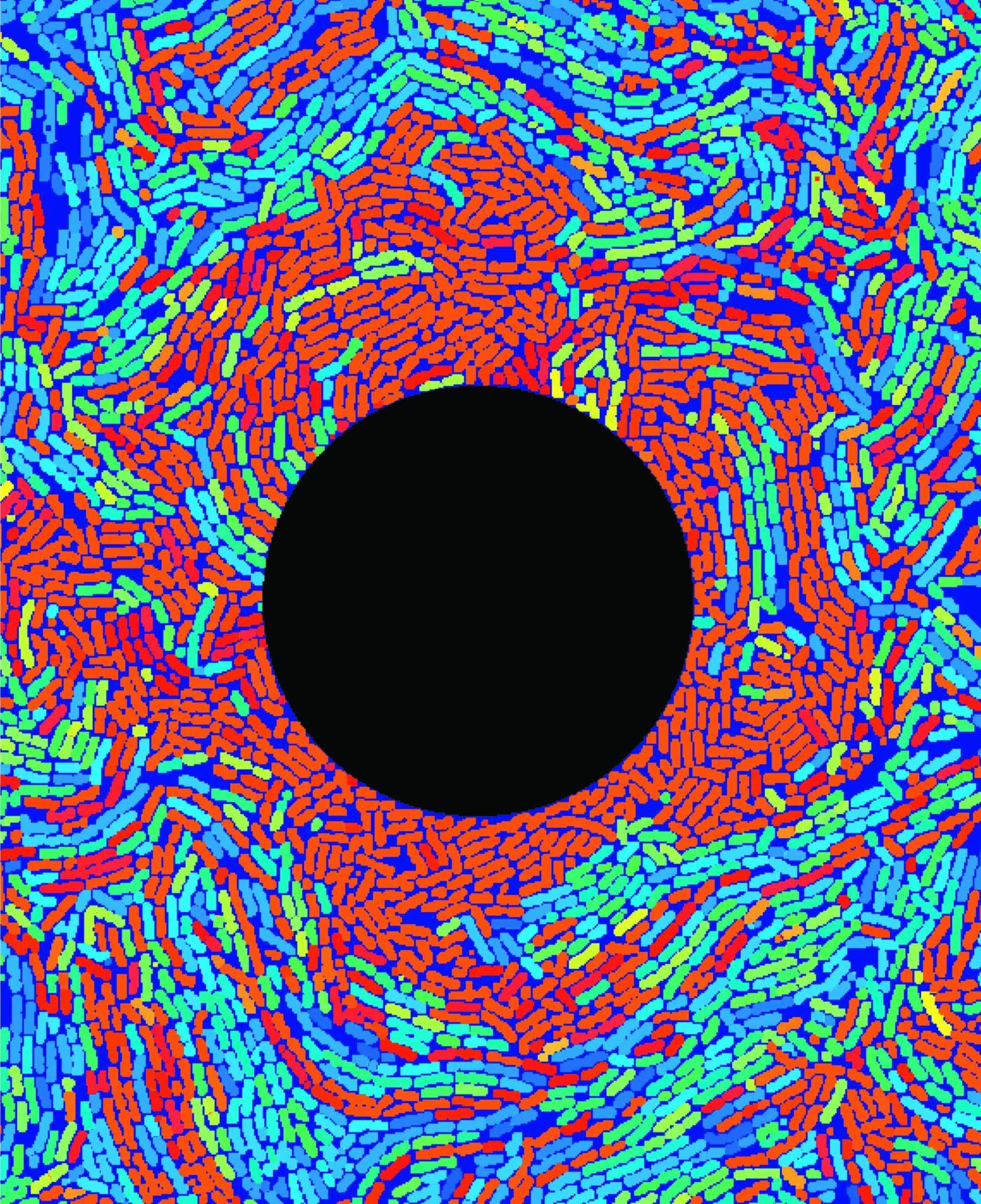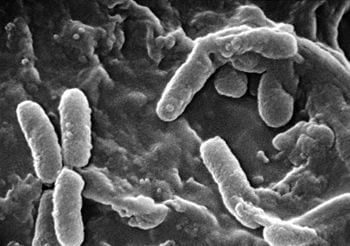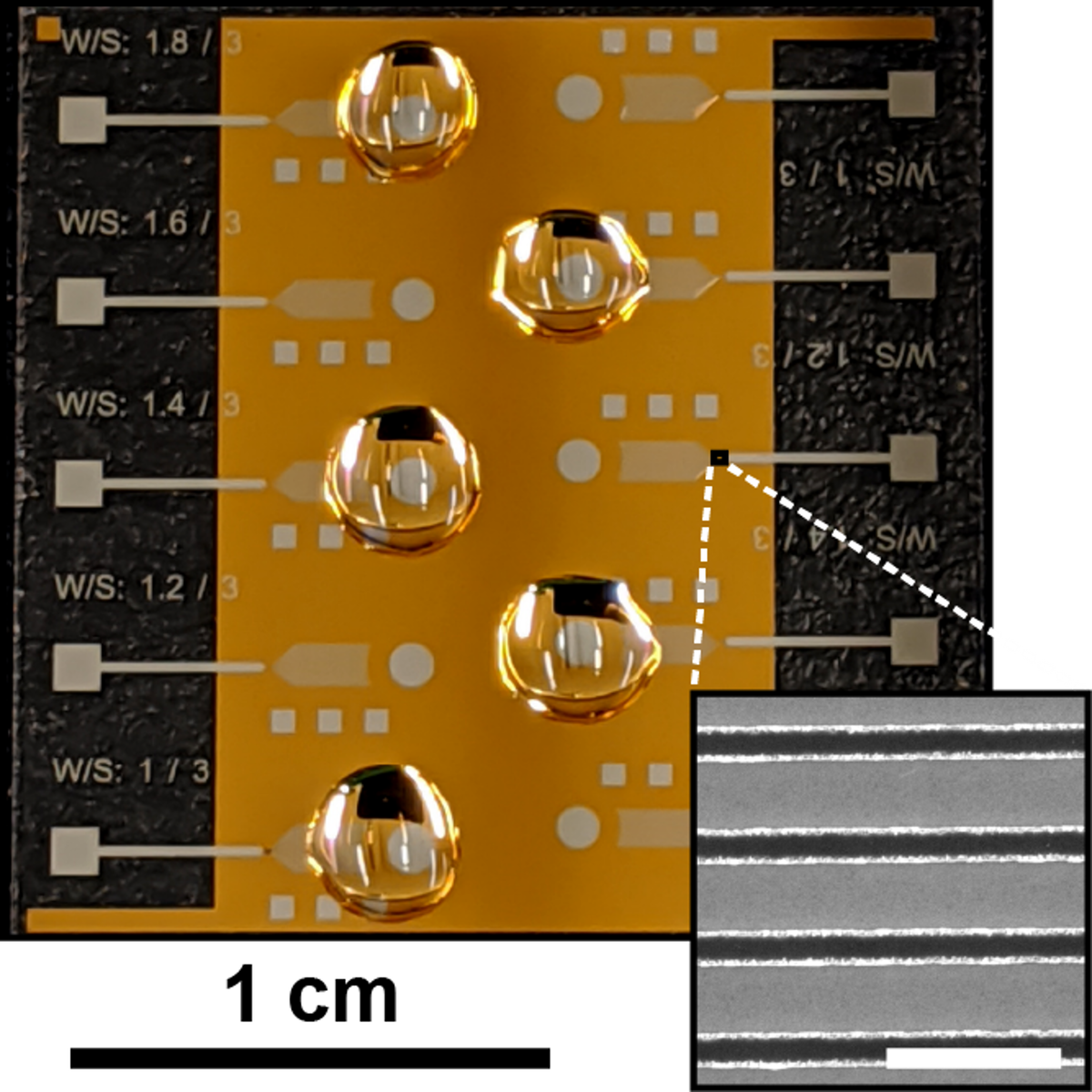
UC San Diego scientists developed a new technology that specifically targets one type of cell among genetically identical bacteria that live in the same microenvironment. They discovered that a second-long shock emitted by an electrode (dark circle in the center), preferentially causes growth of (orange) motile cells, rather than (blue) matrix-producing cells, thereby changing the ratio of cell types in the community.
Credit: Süel Lab, UC San Diego
Scientists find that electrical shocks can change the types of cells in bacterial communities, offering a new approach to precisely control bacteria
Clusters of microscopic bacteria exist all around us. These invisible communities, known as biofilms, are found in habitats ranging from our skin surface to sewer pipes and play integral roles in environments spanning healthcare to agriculture.
Molecular biologists and physicists at the University of California San Diego have joined forces to develop a novel method of using electrical shocks to control the development of communities of bacteria. Their findings, obtained with a newly developed technology, are significant from a medical perspective. In areas where bacteria growth is a concern, biofilms can lead to chronic infections, especially in locations such as hospitals where antibiotic resistance is a major health threat.
Much like other multi-cellular organisms, biofilms are composed of various cell types that carry out specialized roles. For example, matrix-producing cells provide the structural “glue” that holds the bacterial community together while motile cells play a role in the formation and spread of biofilms. The balance of these two cell types defines the physical and biological properties of the biofilm and is also important for its development. If there are too many matrix-producing cells, the biofilm becomes too rigid and cannot grow efficiently. If there are too many motile cells, the biofilm disintegrates as the cells swim away. Thus, changing the ratio of these two cell types offers a precise method for controlling biofilms.
As described May 4, 2022 in the journal Cell Systems, a team at UC San Diego with postdoctoral scholar Colin Comerci and fellow researchers in the laboratory of Professor Gürol Süel in the Department of Molecular Biology, along with colleagues in the Department of Physics, developed a novel microfluidic device and combined it with a multi-electrode array, which allowed them to apply localized electric shocks to a growing biofilm.
To the researchers’ surprise, electrical stimulation caused motile cells to multiply, even though all cells in the biofilm are genetically identical.
“While it is known that electrical shocks can kill cells, here we show that they can cause growth of a specific sub-type of cells,” said Süel, a Biological Sciences professor with affiliations in the San Diego Center for Systems Biology, BioCircuits Institute and Center for Microbiome Innovation. “How a second-long stimulation can promote growth for hours and only of one type of cells is a great puzzle that we are eager to solve.”
“Being able to modulate cell types in this way is not just important for understanding biofilms,” said Comerci. “The electrochemical signals we used are similar to signals used during development in more complicated organisms like frogs, fish or even humans. Thus, our findings may offer analogies to other biological systems.”
Why electrical stimulation boosts the population of one cell type rather than another remains a mystery and continues to be studied at the Süel laboratory. Such influence, the researchers say, provides control of the biofilm’s composition and development, and may offer a new tool to destabilize biofilms in healthcare and agriculture settings.
Original Article: Researchers Manipulate Demographic of Bacterial Community with Novel Electronic Technology
More from: University of California San Diego
The Latest Updates from Bing News & Google News
Go deeper with Bing News on:
Controlling biofilms
- How to clean shoes: Tips and supplies to shape up your footwear
Cleaning your shoes can extend their life, but it’s important to use the right products to avoid damaging the materials. Here's how to clean shoes properly.
- Kauai homeowners sue home construction company over alleged construction defects
Christie Volkmer bought a newly built home on Kauai from D.R. Horton in 2018. Two years later, she and her family noticed something wrong with their water system.
- Massive £31million upgrade of Horsham sewage works enters final year
The major Wastewater Treatment Works scheme is aimed at improving the site’s processes and capacity. The work began in September 2022 and is expected to be completed next spring. Southern Water says ...
- Entering dental awards – why and how?
Join Leanna Ellis and Chris Baker next Wednesday 1 May at 7pm as they discuss entering dental awards – why and how?
- Researchers Unravel Mystery of How Phages Disarm Bacteria
Bacterial infections pose significant challenges to agriculture and medicine, especially as cases of antibiotic-resistant bacteria continue to rise. In response, scientists at Texas A&M AgriLife Resea ...
Go deeper with Google Headlines on:
Controlling biofilms
[google_news title=”” keyword=”controlling biofilms” num_posts=”5″ blurb_length=”0″ show_thumb=”left”]
Go deeper with Bing News on:
Electrical stimulation of cells
- How Effective Is Neuralink’s Blindsight Likely To Be? Scientists Speak On Potential Health Impacts
This week, in ABP Live's science column, we explain how effective Blindsight, the latest endeavour by Elon Musk’s neurotechnology firm Neuralink, is likely to be.
- Magnetic microcoils unlock targeted single-neuron therapies for neurodegenerative disorders
Researchers deploy an array of microscopic coils to create a magnetic field and stimulate individual neurons. The magnetic field can induce an electric field in any nearby neurons, the same effect ...
- MIT Technology Review
Polina Anikeeva, PhD ’09, followed up her ultrathin brain probes with tools to study the gut-brain connection—and now leads an MIT research center investigating neural pathways throughout the body.
- Mum, 28, mistook symptoms for caffeine shakes before devastating diagnosis
A pregnant mum-to-be in her 20s thought she had too much coffee when she noticed her arm shaking, after it didn't improve she sought medical attention and what the doctors told her shocked her whole f ...
- Team demonstrates miniature brain stimulator in humans
Engineers have developed the smallest implantable brain stimulator demonstrated in a human patient that could revolutionize treatment for drug-resistant depression and other psychiatric or ...
Go deeper with Google Headlines on:
Electrical stimulation of cells
[google_news title=”” keyword=”electrical stimulation of cells” num_posts=”5″ blurb_length=”0″ show_thumb=”left”]










